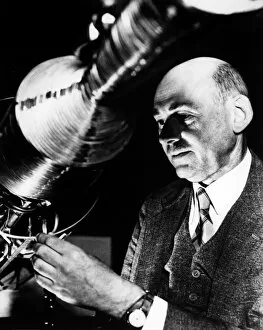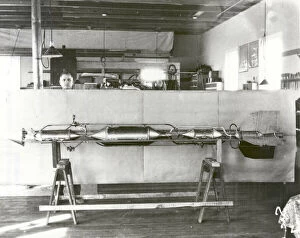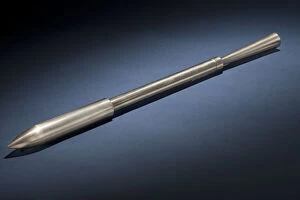Robert Goddard Collection
Dr. Robert Goddard, the American rocketry pioneer, was a visionary ahead of his time. In the 1930s, he embarked on a journey that would revolutionize space exploration
For sale as Licensed Images
Choose your image, Select your licence and Download the media
Dr. Robert Goddard, the American rocketry pioneer, was a visionary ahead of his time. In the 1930s, he embarked on a journey that would revolutionize space exploration. With his groundbreaking inventions and relentless pursuit of knowledge, Goddard paved the way for future generations. One captivating image captures Henry Sachs standing proudly next to Robert Goddard's rocket in New Mexico, USA in 1930. This snapshot showcases the magnitude of their achievement and the immense potential that lay within this innovative creation. Goddard's brilliance is further highlighted by an image from 1918 depicting a solid fuel rocket with smokeless powder – a testament to his early experimentation with propellants. His determination led him to develop crucial components like flow regulators and liquid oxygen systems for rocket engines in later years. In another photograph from 1928, we witness Goddard's ingenuity as he introduces liquid fuel technology alongside an intriguing "hoopskirt" design. These advancements propelled mankind towards greater heights and opened doors to unimaginable possibilities. The genius behind these remarkable achievements is none other than Dr. Robert H. Goddard himself – captured in various images throughout history working diligently on his creations. From designing nozzles for solid fuel rockets to developing intricate pump systems for liquid fuels, every innovation bore his mark of excellence. One cannot overlook the significance of safety valves incorporated into liquid fuel rocket engines during the 1930s - yet another contribution by this extraordinary scientist who prioritized both progress and caution. Perhaps one of Dr. Goddard's most iconic moments was marked by the first flight of a liquid propellant rocket – forever etching his name into history books as a true pioneer in space exploration. As we delve deeper into these photographs capturing Dr. Robert Goddard's staff and vehicles transporting rockets across vast distances using Ford trucks or Dodge touring cars, we gain insight into not only his scientific achievements but also the logistical challenges he faced. Dr.











